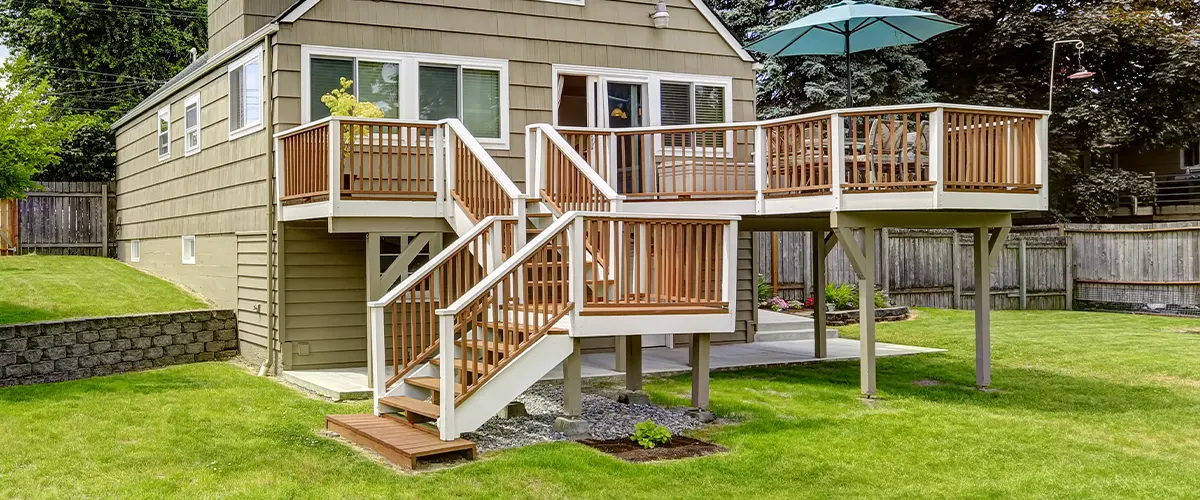Secure Structures, Sensational Decks: The Art of Deck Footings
Wiki Article
Enhance Your Deck's Stability With Proper Deck Footing: Guarantee Durable Longevity and Safety And Security
One key factor that often gets ignored is the correct installment of deck grounds. These footings offer as the foundation of your deck, supplying the needed assistance and stability to withstand the examination of time. In this discussion, we will certainly discover the significance of proper deck ground, guide you via the step-by-step procedure of setup, and highlight the significance of normal maintenance to preserve your deck's security.Why Proper Deck Ground Matters
Correct deck footing is essential for ensuring the security and long-term longevity of any type of deck structure. The deck footing, or foundation, functions as the anchor factor for the entire deck, supporting the weight of the framework and transferring it to the ground below - Deck Footings. Without a strong footing, a deck can end up being unpredictable, resulting in architectural failure and prospective safety dangers
In addition, correct deck footing helps to safeguard versus wetness damages. Wetness can permeate right into the ground and deteriorate the foundation, bring about deteriorating or decay. By making use of proper materials and methods for the ground, such as helical stacks or concrete piers, the deck can be raised over the ground, decreasing call with moisture and extending its life-span.
Understanding the Impact of Soil Conditions
The stability and sturdiness of a deck structure can be considerably affected by the soil conditions in which it is developed. Comprehending the effect of soil conditions is essential for guaranteeing the resilient toughness and security of a deck. Various types of dirt have varying load-bearing capacities, drainage capabilities, and expansion and tightening homes, which can all impact the security of the deck.One crucial aspect to think about is the soil's bearing ability, which describes its capability to support the weight of the deck and any added lots. Dirts with high bearing abilities, such as compressed crushed rock or clay, are excellent for sustaining hefty frameworks like decks. On the various other hand, dirts with low bearing capacities, such as loosened sand or soft clay, may need additional actions to enhance stability, such as deep footings or dirt stablizing methods.

In addition, the soil's tendency to acquire and broaden with adjustments in moisture material can impact the security of the deck. Dirts with high clay web content are prone to substantial development and tightening, which can cause working out and changing of the deck structure. Appropriate actions, such as setting up moisture obstacles or utilizing different structure systems, may be called for to reduce the results of soil motion.
Selecting the Right Ground Materials
What aspects should be thought about when choosing the proper ground products for a deck? Picking the ideal footing products is important for guaranteeing the stability and durability of a deck. Numerous variables need to be considered when making this decision.To start Learn More with, the kind of soil in the location plays an important role in figuring out the appropriate ground products. Different dirts have varying load-bearing abilities, so it is very important to select products that can properly support the weight of the deck and any kind of prospective tons it may birth.
Secondly, the climate and weather of the area must be considered. In areas with rough winters months or high degrees of dampness, footing materials that are immune to rust and decay, such as treated or concrete timber, are recommended. These materials are much more durable and much less susceptible to damage from freezing temperature levels, wetness, and pests.
Moreover, the size and height of the deck also affect the option of footing materials. Larger and taller decks require more considerable footings to ensure stability and stop moving or sinking. In such instances, products like concrete footings or helical piers might be preferable.
Finally, budget factors to consider need to not be forgotten. While some materials may offer superior resilience and efficiency, they may also feature a higher rate tag. It is necessary to strike a balance in between cost and top quality when selecting the ideal footing products for a deck.
Step-by-Step Guide to Putting Up Deck Footings
When setting up deck grounds, it is necessary to adhere to a step-by-step overview to ensure stability and longevity. By complying with these actions, you can guarantee that your deck will certainly be able to stand up to the examination of time and provide a satisfying and secure outdoor area for years ahead.The primary step in setting up deck grounds is to determine the place and format of your deck. This includes measuring and noting the location where the grounds will be put. It is very important to ensure that the footings are uniformly spaced and aligned with the deck's layout.
Following, you will need to dig the holes for the footings. The deepness and size of the holes will certainly depend on the size and weight of your deck. It is vital to dig the holes deep enough to reach below the frost line to avoid frost heave.
Once the holes are dug, you can begin putting the concrete footings. It is advised to utilize a pre-mixed concrete mix for this action. Fill up the holes with concrete, making sure that it is level and smooth. Related Site Make use of a post level to make sure that the footings are plumb.
After the footings have actually been poured, permit the concrete to cure for at the very least 48 hours prior to waging the deck installation. This will certainly make certain that the grounds have actually solidified and are ready to sustain the weight of the deck.
Routine Maintenance to Preserve Deck Security
To keep the stability of your deck, routine upkeep is necessary. By implementing a regular maintenance routine, you can ensure that your deck remains risk-free, resilient, and aesthetically enticing. One crucial element of maintenance is inspecting the deck for any type of signs of damage or wear. This consists of checking for broken or loosened boards, rusted screws or nails, and any type of indicators of rot or decay. It is essential to attend to these problems without delay to avoid more damage and possible security risks.Cleansing your deck regularly is an additional important maintenance task. Additionally, routinely applying a protective sealer can help protect against moisture damages and lengthen the life of your deck.
In enhancement to these normal upkeep tasks, it is likewise suggested to perform a comprehensive evaluation of the deck's structural parts a minimum of yearly. This consists of examining the condition of the footings, beams, joists, and articles. Any type of indicators of deterioration or weakness ought to be addressed without delay to make sure the ongoing security and safety of the deck.
Conclusion
In verdict, correct deck ground is necessary for ensuring the long-lasting sturdiness and safety of your deck. Recognizing the effect of soil problems and choosing the appropriate footing products are crucial action in this process. By complying with a detailed guide to mounting deck grounds and routinely maintaining them, you can improve your deck's stability. Ultimately, these steps will certainly aid preserve your deck's integrity and make sure a enjoyable and secure exterior space for years to find.In this discussion, we will discover the significance of appropriate deck ground, guide you with the step-by-step process of setup, and highlight the significance of routine upkeep to maintain your deck's stability.
Correct deck ground is critical for ensuring the stability and long-lasting longevity of any type of deck structure.One of the main reasons why correct deck footing matters is to protect against the deck from moving or sinking over time (Deck Footings).In verdict, correct deck ground is vital for making certain the lasting sturdiness and safety of your investigate this site deck. By complying with a detailed guide to installing deck grounds and consistently preserving them, you can enhance your deck's stability
Report this wiki page